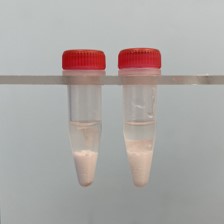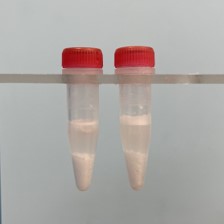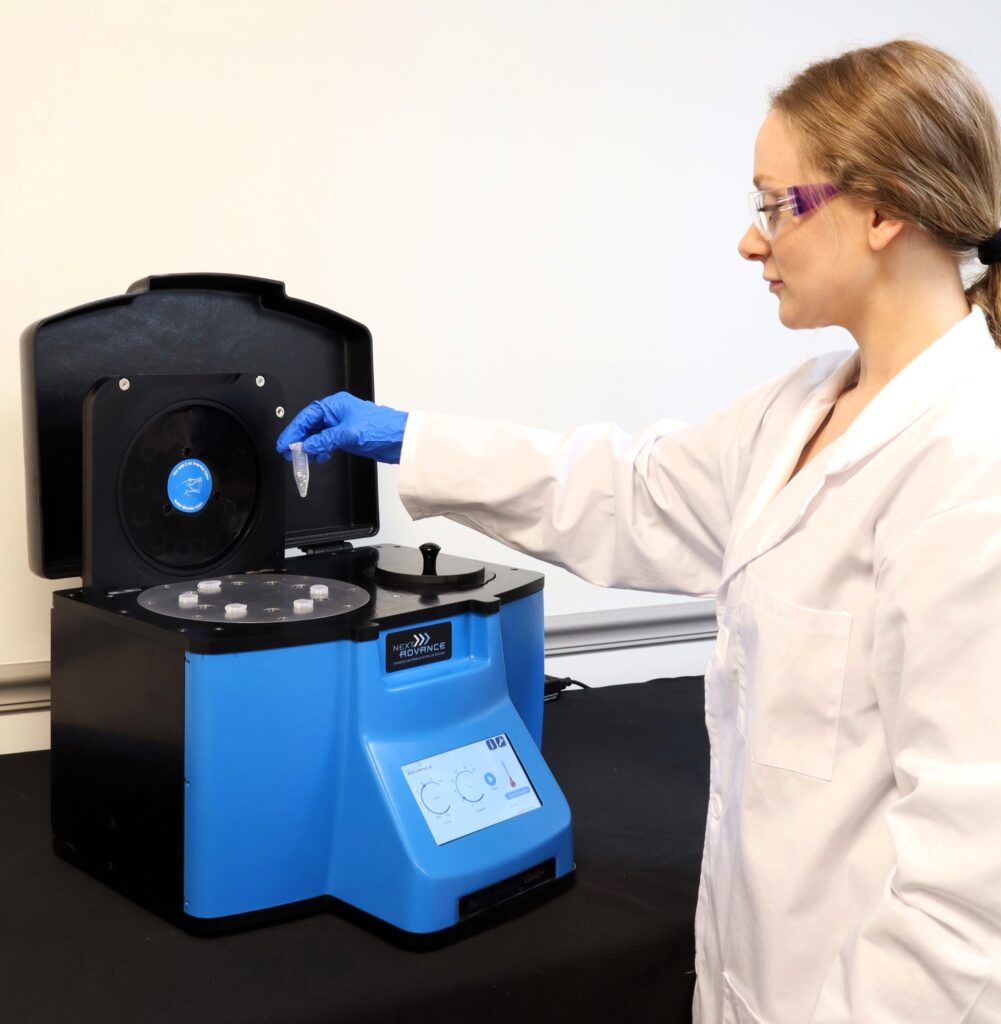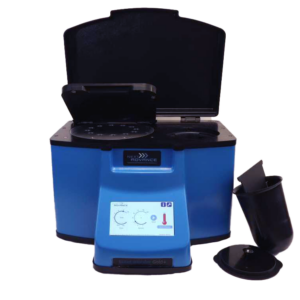Ideal for Ear Tissue Homogenization
Do you spend lots of time and effort homogenizing ear tissue samples? The Bullet Blender® tissue homogenizer delivers high quality and superior yields. No other homogenizer comes close to delivering the Bullet Blender’s winning combination of top-quality performance and budget-friendly affordability. See below for a ear tissue homogenization protocol.
Save Time, Effort and Get Superior Results with
The Bullet Blender Homogenizer
Consistent and High Yield Results
Run up to 24 samples at the same time under microprocessor-controlled conditions, ensuring experimental reproducibility and high yield. Process samples from 10mg or less up to 3.5g.No Cross Contamination
No part of the Bullet Blender ever touches the tissue – the sample tubes are kept closed during homogenization. There are no probes to clean between samples.Samples Stay Cool
The Bullet Blenders’ innovative and elegant design provides convective cooling of the samples, so they do not heat up more than several degrees. In fact, our Gold+ models hold the sample temperature to about 4ºC.Easy and Convenient to Use
Just place beads and buffer along with your tissue sample in standard tubes, load tubes directly in the Bullet Blender, select time and speed, and press start.Risk Free Purchase
Thousands of peer-reviewed journal articles attest to the consistency and quality of the Bullet Blender homogenizer. We offer a 2 year warranty, extendable to 4 years, because our Bullet Blenders are reliable and last for many years.Ear Tissue Homogenization Protocol
Sample size |
See the Protocol |
| microcentrifuge tube model (up to 300 mg) | Small ear samples |
What Else Can You Homogenize? Tough or Soft, No Problem!
The Bullet Blender can process a wide range of samples including organ tissue, cell culture, plant tissue, and small organisms. You can homogenize samples as tough as mouse femur or for gentle applications such as tissue dissociation or organelle isolation.



Ear tissue pieces (on beads in upper photo) are completely homogenized into the buffer (slightly darker in lower photo).
Want more guidance? Need a quote? Contact us:

Bullet Blender Models
Select Publications using the Bullet Blender to Homogenize Ear Tissue
2474232
ear
1
apa
50
date
desc
3148
https://www.nextadvance.com/wp-content/plugins/zotpress/
%7B%22status%22%3A%22success%22%2C%22updateneeded%22%3Afalse%2C%22instance%22%3Afalse%2C%22meta%22%3A%7B%22request_last%22%3A0%2C%22request_next%22%3A0%2C%22used_cache%22%3Atrue%7D%2C%22data%22%3A%5B%7B%22key%22%3A%225B24X2TU%22%2C%22library%22%3A%7B%22id%22%3A2474232%7D%2C%22meta%22%3A%7B%22creatorSummary%22%3A%22Jo%20et%20al.%22%2C%22parsedDate%22%3A%222015-08-11%22%2C%22numChildren%22%3A0%7D%2C%22bib%22%3A%22%3Cdiv%20class%3D%5C%22csl-bib-body%5C%22%20style%3D%5C%22line-height%3A%202%3B%20padding-left%3A%201em%3B%20text-indent%3A-1em%3B%5C%22%3E%5Cn%20%20%3Cdiv%20class%3D%5C%22csl-entry%5C%22%3EJo%2C%20S.%2C%20Ryu%2C%20J.%2C%20Kim%2C%20H.%2C%20Kim%2C%20M.%2C%20Ryu%2C%20M.%20H.%2C%20Kim%2C%20H.%2C%20%26amp%3B%20Cho%2C%20S.-I.%20%282015%29.%20Anti-inflammatory%20effects%20of%20Sanguisorbae%20Radix%20on%20contact%20dermatitis%20induced%20by%20dinitrofluorobenzene%20in%20mice.%20%3Ci%3EChinese%20Journal%20of%20Integrative%20Medicine%3C%5C%2Fi%3E.%20%3Ca%20class%3D%27zp-DOIURL%27%20href%3D%27https%3A%5C%2F%5C%2Fdoi.org%5C%2F10.1007%5C%2Fs11655-015-2148-8%27%3Ehttps%3A%5C%2F%5C%2Fdoi.org%5C%2F10.1007%5C%2Fs11655-015-2148-8%3C%5C%2Fa%3E%3C%5C%2Fdiv%3E%5Cn%3C%5C%2Fdiv%3E%22%2C%22data%22%3A%7B%22itemType%22%3A%22journalArticle%22%2C%22title%22%3A%22Anti-inflammatory%20effects%20of%20Sanguisorbae%20Radix%20on%20contact%20dermatitis%20induced%20by%20dinitrofluorobenzene%20in%20mice%22%2C%22creators%22%3A%5B%7B%22creatorType%22%3A%22author%22%2C%22firstName%22%3A%22Suzy%22%2C%22lastName%22%3A%22Jo%22%7D%2C%7B%22creatorType%22%3A%22author%22%2C%22firstName%22%3A%22Junghyun%22%2C%22lastName%22%3A%22Ryu%22%7D%2C%7B%22creatorType%22%3A%22author%22%2C%22firstName%22%3A%22Hanna%22%2C%22lastName%22%3A%22Kim%22%7D%2C%7B%22creatorType%22%3A%22author%22%2C%22firstName%22%3A%22Miyoung%22%2C%22lastName%22%3A%22Kim%22%7D%2C%7B%22creatorType%22%3A%22author%22%2C%22firstName%22%3A%22Mi%20Heon%22%2C%22lastName%22%3A%22Ryu%22%7D%2C%7B%22creatorType%22%3A%22author%22%2C%22firstName%22%3A%22Hyungwoo%22%2C%22lastName%22%3A%22Kim%22%7D%2C%7B%22creatorType%22%3A%22author%22%2C%22firstName%22%3A%22Su-In%22%2C%22lastName%22%3A%22Cho%22%7D%5D%2C%22abstractNote%22%3A%22%22%2C%22date%22%3A%222015-8-11%22%2C%22language%22%3A%22en%22%2C%22DOI%22%3A%2210.1007%5C%2Fs11655-015-2148-8%22%2C%22ISSN%22%3A%221672-0415%2C%201993-0402%22%2C%22url%22%3A%22http%3A%5C%2F%5C%2Flink.springer.com%5C%2F10.1007%5C%2Fs11655-015-2148-8%22%2C%22collections%22%3A%5B%22M2MNG549%22%5D%2C%22dateModified%22%3A%222015-12-30T21%3A27%3A55Z%22%7D%7D%2C%7B%22key%22%3A%2239R9EEHH%22%2C%22library%22%3A%7B%22id%22%3A2474232%7D%2C%22meta%22%3A%7B%22creatorSummary%22%3A%22Lee%20et%20al.%22%2C%22parsedDate%22%3A%222015-04-15%22%2C%22numChildren%22%3A0%7D%2C%22bib%22%3A%22%3Cdiv%20class%3D%5C%22csl-bib-body%5C%22%20style%3D%5C%22line-height%3A%202%3B%20padding-left%3A%201em%3B%20text-indent%3A-1em%3B%5C%22%3E%5Cn%20%20%3Cdiv%20class%3D%5C%22csl-entry%5C%22%3ELee%2C%20H.%2C%20Jo%2C%20S.%2C%20Ryu%2C%20J.%2C%20Jeong%2C%20H.%2C%20Lee%2C%20G.%2C%20Ryu%2C%20M.%2C%20Jung%2C%20M.%2C%20Kim%2C%20H.%2C%20%26amp%3B%20Kim%2C%20B.%20%282015%29.%20Effects%20of%20Schisandra%20chinensis%20Turcz.%20fruit%20on%20contact%20dermatitis%20induced%20by%20dinitrofluorobenzene%20in%20mice.%20%3Ci%3EMolecular%20Medicine%20Reports%3C%5C%2Fi%3E.%20%3Ca%20class%3D%27zp-DOIURL%27%20href%3D%27https%3A%5C%2F%5C%2Fdoi.org%5C%2F10.3892%5C%2Fmmr.2015.3618%27%3Ehttps%3A%5C%2F%5C%2Fdoi.org%5C%2F10.3892%5C%2Fmmr.2015.3618%3C%5C%2Fa%3E%3C%5C%2Fdiv%3E%5Cn%3C%5C%2Fdiv%3E%22%2C%22data%22%3A%7B%22itemType%22%3A%22journalArticle%22%2C%22title%22%3A%22Effects%20of%20Schisandra%20chinensis%20Turcz.%20fruit%20on%20contact%20dermatitis%20induced%20by%20dinitrofluorobenzene%20in%20mice%22%2C%22creators%22%3A%5B%7B%22creatorType%22%3A%22author%22%2C%22firstName%22%3A%22Hee%22%2C%22lastName%22%3A%22Lee%22%7D%2C%7B%22creatorType%22%3A%22author%22%2C%22firstName%22%3A%22Suzy%22%2C%22lastName%22%3A%22Jo%22%7D%2C%7B%22creatorType%22%3A%22author%22%2C%22firstName%22%3A%22Jeonghyun%22%2C%22lastName%22%3A%22Ryu%22%7D%2C%7B%22creatorType%22%3A%22author%22%2C%22firstName%22%3A%22Han%5Cu2011Sol%22%2C%22lastName%22%3A%22Jeong%22%7D%2C%7B%22creatorType%22%3A%22author%22%2C%22firstName%22%3A%22Guemsan%22%2C%22lastName%22%3A%22Lee%22%7D%2C%7B%22creatorType%22%3A%22author%22%2C%22firstName%22%3A%22Mi%22%2C%22lastName%22%3A%22Ryu%22%7D%2C%7B%22creatorType%22%3A%22author%22%2C%22firstName%22%3A%22Myeong%22%2C%22lastName%22%3A%22Jung%22%7D%2C%7B%22creatorType%22%3A%22author%22%2C%22firstName%22%3A%22Hyungwoo%22%2C%22lastName%22%3A%22Kim%22%7D%2C%7B%22creatorType%22%3A%22author%22%2C%22firstName%22%3A%22Byung%22%2C%22lastName%22%3A%22Kim%22%7D%5D%2C%22abstractNote%22%3A%22%22%2C%22date%22%3A%222015-04-15%22%2C%22language%22%3A%22%22%2C%22DOI%22%3A%2210.3892%5C%2Fmmr.2015.3618%22%2C%22ISSN%22%3A%221791-2997%2C%201791-3004%22%2C%22url%22%3A%22http%3A%5C%2F%5C%2Fwww.spandidos-publications.com%5C%2F10.3892%5C%2Fmmr.2015.3618%22%2C%22collections%22%3A%5B%22M2MNG549%22%5D%2C%22dateModified%22%3A%222015-12-30T21%3A20%3A15Z%22%7D%7D%2C%7B%22key%22%3A%22FWJEKM9C%22%2C%22library%22%3A%7B%22id%22%3A2474232%7D%2C%22meta%22%3A%7B%22creatorSummary%22%3A%22Kim%20et%20al.%22%2C%22parsedDate%22%3A%222014%22%2C%22numChildren%22%3A0%7D%2C%22bib%22%3A%22%3Cdiv%20class%3D%5C%22csl-bib-body%5C%22%20style%3D%5C%22line-height%3A%202%3B%20padding-left%3A%201em%3B%20text-indent%3A-1em%3B%5C%22%3E%5Cn%20%20%3Cdiv%20class%3D%5C%22csl-entry%5C%22%3EKim%2C%20H.%2C%20Cho%2C%20S.%2C%20Kim%2C%20M.%2C%20Kim%2C%20H.%2C%20Ryu%2C%20J.%2C%20Jo%2C%20S.%2C%20Lee%2C%20G.%2C%20%26amp%3B%20Ryu%2C%20M.%20%282014%29.%20Anti-inflammatory%20effects%20of%20Cryptotympana%20atrata%20Fabricius%20slough%20shed%20on%20contact%20dermatitis%20induced%20by%20dinitrofluorobenzene%20in%20mice.%20%3Ci%3EPharmacognosy%20Magazine%3C%5C%2Fi%3E%2C%20%3Ci%3E10%3C%5C%2Fi%3E%2838%29%2C%20377.%20%3Ca%20class%3D%27zp-DOIURL%27%20href%3D%27https%3A%5C%2F%5C%2Fdoi.org%5C%2F10.4103%5C%2F0973-1296.133288%27%3Ehttps%3A%5C%2F%5C%2Fdoi.org%5C%2F10.4103%5C%2F0973-1296.133288%3C%5C%2Fa%3E%3C%5C%2Fdiv%3E%5Cn%3C%5C%2Fdiv%3E%22%2C%22data%22%3A%7B%22itemType%22%3A%22journalArticle%22%2C%22title%22%3A%22Anti-inflammatory%20effects%20of%20Cryptotympana%20atrata%20Fabricius%20slough%20shed%20on%20contact%20dermatitis%20induced%20by%20dinitrofluorobenzene%20in%20mice%22%2C%22creators%22%3A%5B%7B%22creatorType%22%3A%22author%22%2C%22firstName%22%3A%22Hyungwoo%22%2C%22lastName%22%3A%22Kim%22%7D%2C%7B%22creatorType%22%3A%22author%22%2C%22firstName%22%3A%22SuIn%22%2C%22lastName%22%3A%22Cho%22%7D%2C%7B%22creatorType%22%3A%22author%22%2C%22firstName%22%3A%22Miyoung%22%2C%22lastName%22%3A%22Kim%22%7D%2C%7B%22creatorType%22%3A%22author%22%2C%22firstName%22%3A%22Hanna%22%2C%22lastName%22%3A%22Kim%22%7D%2C%7B%22creatorType%22%3A%22author%22%2C%22firstName%22%3A%22Jeonghyun%22%2C%22lastName%22%3A%22Ryu%22%7D%2C%7B%22creatorType%22%3A%22author%22%2C%22firstName%22%3A%22Suzy%22%2C%22lastName%22%3A%22Jo%22%7D%2C%7B%22creatorType%22%3A%22author%22%2C%22firstName%22%3A%22Guemsan%22%2C%22lastName%22%3A%22Lee%22%7D%2C%7B%22creatorType%22%3A%22author%22%2C%22firstName%22%3A%22MiHeon%22%2C%22lastName%22%3A%22Ryu%22%7D%5D%2C%22abstractNote%22%3A%22%22%2C%22date%22%3A%222014%22%2C%22language%22%3A%22en%22%2C%22DOI%22%3A%2210.4103%5C%2F0973-1296.133288%22%2C%22ISSN%22%3A%220973-1296%22%2C%22url%22%3A%22http%3A%5C%2F%5C%2Fwww.phcog.com%5C%2Ftext.asp%3F2014%5C%2F10%5C%2F38%5C%2F377%5C%2F133288%22%2C%22collections%22%3A%5B%22M2MNG549%22%5D%2C%22dateModified%22%3A%222016-01-12T17%3A22%3A57Z%22%7D%7D%2C%7B%22key%22%3A%22ZC6I5UV7%22%2C%22library%22%3A%7B%22id%22%3A2474232%7D%2C%22meta%22%3A%7B%22creatorSummary%22%3A%22Liu%20et%20al.%22%2C%22parsedDate%22%3A%222013-09-01%22%2C%22numChildren%22%3A0%7D%2C%22bib%22%3A%22%3Cdiv%20class%3D%5C%22csl-bib-body%5C%22%20style%3D%5C%22line-height%3A%202%3B%20padding-left%3A%201em%3B%20text-indent%3A-1em%3B%5C%22%3E%5Cn%20%20%3Cdiv%20class%3D%5C%22csl-entry%5C%22%3ELiu%2C%20B.%2C%20Escalera%2C%20J.%2C%20Balakrishna%2C%20S.%2C%20Fan%2C%20L.%2C%20Caceres%2C%20A.%20I.%2C%20Robinson%2C%20E.%2C%20Sui%2C%20A.%2C%20McKay%2C%20M.%20C.%2C%20McAlexander%2C%20M.%20A.%2C%20Herrick%2C%20C.%20A.%2C%20%26amp%3B%20Jordt%2C%20S.%20E.%20%282013%29.%20TRPA1%20controls%20inflammation%20and%20pruritogen%20responses%20in%20allergic%20contact%20dermatitis.%20%3Ci%3EThe%20FASEB%20Journal%3C%5C%2Fi%3E%2C%20%3Ci%3E27%3C%5C%2Fi%3E%289%29%2C%203549%26%23x2013%3B3563.%20%3Ca%20class%3D%27zp-DOIURL%27%20href%3D%27https%3A%5C%2F%5C%2Fdoi.org%5C%2F10.1096%5C%2Ffj.13-229948%27%3Ehttps%3A%5C%2F%5C%2Fdoi.org%5C%2F10.1096%5C%2Ffj.13-229948%3C%5C%2Fa%3E%3C%5C%2Fdiv%3E%5Cn%3C%5C%2Fdiv%3E%22%2C%22data%22%3A%7B%22itemType%22%3A%22journalArticle%22%2C%22title%22%3A%22TRPA1%20controls%20inflammation%20and%20pruritogen%20responses%20in%20allergic%20contact%20dermatitis%22%2C%22creators%22%3A%5B%7B%22creatorType%22%3A%22author%22%2C%22firstName%22%3A%22B.%22%2C%22lastName%22%3A%22Liu%22%7D%2C%7B%22creatorType%22%3A%22author%22%2C%22firstName%22%3A%22J.%22%2C%22lastName%22%3A%22Escalera%22%7D%2C%7B%22creatorType%22%3A%22author%22%2C%22firstName%22%3A%22S.%22%2C%22lastName%22%3A%22Balakrishna%22%7D%2C%7B%22creatorType%22%3A%22author%22%2C%22firstName%22%3A%22L.%22%2C%22lastName%22%3A%22Fan%22%7D%2C%7B%22creatorType%22%3A%22author%22%2C%22firstName%22%3A%22A.%20I.%22%2C%22lastName%22%3A%22Caceres%22%7D%2C%7B%22creatorType%22%3A%22author%22%2C%22firstName%22%3A%22E.%22%2C%22lastName%22%3A%22Robinson%22%7D%2C%7B%22creatorType%22%3A%22author%22%2C%22firstName%22%3A%22A.%22%2C%22lastName%22%3A%22Sui%22%7D%2C%7B%22creatorType%22%3A%22author%22%2C%22firstName%22%3A%22M.%20C.%22%2C%22lastName%22%3A%22McKay%22%7D%2C%7B%22creatorType%22%3A%22author%22%2C%22firstName%22%3A%22M.%20A.%22%2C%22lastName%22%3A%22McAlexander%22%7D%2C%7B%22creatorType%22%3A%22author%22%2C%22firstName%22%3A%22C.%20A.%22%2C%22lastName%22%3A%22Herrick%22%7D%2C%7B%22creatorType%22%3A%22author%22%2C%22firstName%22%3A%22S.%20E.%22%2C%22lastName%22%3A%22Jordt%22%7D%5D%2C%22abstractNote%22%3A%22%22%2C%22date%22%3A%222013-09-01%22%2C%22language%22%3A%22en%22%2C%22DOI%22%3A%2210.1096%5C%2Ffj.13-229948%22%2C%22ISSN%22%3A%220892-6638%2C%201530-6860%22%2C%22url%22%3A%22http%3A%5C%2F%5C%2Fwww.fasebj.org%5C%2Fcgi%5C%2Fdoi%5C%2F10.1096%5C%2Ffj.13-229948%22%2C%22collections%22%3A%5B%22M2MNG549%22%5D%2C%22dateModified%22%3A%222015-07-14T16%3A25%3A46Z%22%7D%7D%2C%7B%22key%22%3A%22DU7X4UJQ%22%2C%22library%22%3A%7B%22id%22%3A2474232%7D%2C%22meta%22%3A%7B%22creatorSummary%22%3A%22Dong%20et%20al.%22%2C%22parsedDate%22%3A%222013-02-01%22%2C%22numChildren%22%3A0%7D%2C%22bib%22%3A%22%3Cdiv%20class%3D%5C%22csl-bib-body%5C%22%20style%3D%5C%22line-height%3A%202%3B%20padding-left%3A%201em%3B%20text-indent%3A-1em%3B%5C%22%3E%5Cn%20%20%3Cdiv%20class%3D%5C%22csl-entry%5C%22%3EDong%2C%20C.%2C%20Sexton%2C%20H.%2C%20Gertrudes%2C%20A.%2C%20Akama%2C%20T.%2C%20Martin%2C%20S.%2C%20Virtucio%2C%20C.%2C%20Chen%2C%20C.-W.%2C%20Fan%2C%20X.%2C%20Wu%2C%20A.%2C%20Bu%2C%20W.%2C%20Liu%2C%20L.%2C%20Feng%2C%20L.%2C%20Jarnagin%2C%20K.%2C%20%26amp%3B%20Freund%2C%20Y.%20R.%20%282013%29.%20Inhibition%20of%20Toll-Like%20Receptor-Mediated%20Inflammation%20In%20Vitro%20and%20In%20Vivo%20by%20a%20Novel%20Benzoxaborole.%20%3Ci%3EJournal%20of%20Pharmacology%20and%20Experimental%20Therapeutics%3C%5C%2Fi%3E%2C%20%3Ci%3E344%3C%5C%2Fi%3E%282%29%2C%20436%26%23x2013%3B446.%20%3Ca%20class%3D%27zp-DOIURL%27%20href%3D%27https%3A%5C%2F%5C%2Fdoi.org%5C%2F10.1124%5C%2Fjpet.112.200030%27%3Ehttps%3A%5C%2F%5C%2Fdoi.org%5C%2F10.1124%5C%2Fjpet.112.200030%3C%5C%2Fa%3E%3C%5C%2Fdiv%3E%5Cn%3C%5C%2Fdiv%3E%22%2C%22data%22%3A%7B%22itemType%22%3A%22journalArticle%22%2C%22title%22%3A%22Inhibition%20of%20Toll-Like%20Receptor-Mediated%20Inflammation%20In%20Vitro%20and%20In%20Vivo%20by%20a%20Novel%20Benzoxaborole%22%2C%22creators%22%3A%5B%7B%22creatorType%22%3A%22author%22%2C%22firstName%22%3A%22C.%22%2C%22lastName%22%3A%22Dong%22%7D%2C%7B%22creatorType%22%3A%22author%22%2C%22firstName%22%3A%22H.%22%2C%22lastName%22%3A%22Sexton%22%7D%2C%7B%22creatorType%22%3A%22author%22%2C%22firstName%22%3A%22A.%22%2C%22lastName%22%3A%22Gertrudes%22%7D%2C%7B%22creatorType%22%3A%22author%22%2C%22firstName%22%3A%22T.%22%2C%22lastName%22%3A%22Akama%22%7D%2C%7B%22creatorType%22%3A%22author%22%2C%22firstName%22%3A%22S.%22%2C%22lastName%22%3A%22Martin%22%7D%2C%7B%22creatorType%22%3A%22author%22%2C%22firstName%22%3A%22C.%22%2C%22lastName%22%3A%22Virtucio%22%7D%2C%7B%22creatorType%22%3A%22author%22%2C%22firstName%22%3A%22C.-W.%22%2C%22lastName%22%3A%22Chen%22%7D%2C%7B%22creatorType%22%3A%22author%22%2C%22firstName%22%3A%22X.%22%2C%22lastName%22%3A%22Fan%22%7D%2C%7B%22creatorType%22%3A%22author%22%2C%22firstName%22%3A%22A.%22%2C%22lastName%22%3A%22Wu%22%7D%2C%7B%22creatorType%22%3A%22author%22%2C%22firstName%22%3A%22W.%22%2C%22lastName%22%3A%22Bu%22%7D%2C%7B%22creatorType%22%3A%22author%22%2C%22firstName%22%3A%22L.%22%2C%22lastName%22%3A%22Liu%22%7D%2C%7B%22creatorType%22%3A%22author%22%2C%22firstName%22%3A%22L.%22%2C%22lastName%22%3A%22Feng%22%7D%2C%7B%22creatorType%22%3A%22author%22%2C%22firstName%22%3A%22K.%22%2C%22lastName%22%3A%22Jarnagin%22%7D%2C%7B%22creatorType%22%3A%22author%22%2C%22firstName%22%3A%22Y.%20R.%22%2C%22lastName%22%3A%22Freund%22%7D%5D%2C%22abstractNote%22%3A%22%22%2C%22date%22%3A%222013-02-01%22%2C%22language%22%3A%22en%22%2C%22DOI%22%3A%2210.1124%5C%2Fjpet.112.200030%22%2C%22ISSN%22%3A%221521-0103%22%2C%22url%22%3A%22http%3A%5C%2F%5C%2Fjpet.aspetjournals.org%5C%2Fcgi%5C%2Fdoi%5C%2F10.1124%5C%2Fjpet.112.200030%22%2C%22collections%22%3A%5B%22M2MNG549%22%5D%2C%22dateModified%22%3A%222015-07-14T16%3A07%3A02Z%22%7D%7D%2C%7B%22key%22%3A%225HB4KMQA%22%2C%22library%22%3A%7B%22id%22%3A2474232%7D%2C%22meta%22%3A%7B%22creatorSummary%22%3A%22Kim%20et%20al.%22%2C%22parsedDate%22%3A%222013%22%2C%22numChildren%22%3A0%7D%2C%22bib%22%3A%22%3Cdiv%20class%3D%5C%22csl-bib-body%5C%22%20style%3D%5C%22line-height%3A%202%3B%20padding-left%3A%201em%3B%20text-indent%3A-1em%3B%5C%22%3E%5Cn%20%20%3Cdiv%20class%3D%5C%22csl-entry%5C%22%3EKim%2C%20H.%2C%20Kim%2C%20M.%2C%20Kim%2C%20H.%2C%20San%20Lee%2C%20G.%2C%20Gun%20An%2C%20W.%2C%20%26amp%3B%20In%20Cho%2C%20S.%20%282013%29.%20Anti-inflammatory%20activities%20of%20Dictamnus%20dasycarpus%20Turcz.%2C%20root%20bark%20on%20allergic%20contact%20dermatitis%20induced%20by%20dinitrofluorobenzene%20in%20mice.%20%3Ci%3EJournal%20of%20Ethnopharmacology%3C%5C%2Fi%3E%2C%20%3Ci%3E149%3C%5C%2Fi%3E%282%29%2C%20471%26%23x2013%3B477.%20%3Ca%20class%3D%27zp-DOIURL%27%20href%3D%27https%3A%5C%2F%5C%2Fdoi.org%5C%2F10.1016%5C%2Fj.jep.2013.06.055%27%3Ehttps%3A%5C%2F%5C%2Fdoi.org%5C%2F10.1016%5C%2Fj.jep.2013.06.055%3C%5C%2Fa%3E%3C%5C%2Fdiv%3E%5Cn%3C%5C%2Fdiv%3E%22%2C%22data%22%3A%7B%22itemType%22%3A%22journalArticle%22%2C%22title%22%3A%22Anti-inflammatory%20activities%20of%20Dictamnus%20dasycarpus%20Turcz.%2C%20root%20bark%20on%20allergic%20contact%20dermatitis%20induced%20by%20dinitrofluorobenzene%20in%20mice%22%2C%22creators%22%3A%5B%7B%22creatorType%22%3A%22author%22%2C%22firstName%22%3A%22Hyungwoo%22%2C%22lastName%22%3A%22Kim%22%7D%2C%7B%22creatorType%22%3A%22author%22%2C%22firstName%22%3A%22Miyoung%22%2C%22lastName%22%3A%22Kim%22%7D%2C%7B%22creatorType%22%3A%22author%22%2C%22firstName%22%3A%22Hanna%22%2C%22lastName%22%3A%22Kim%22%7D%2C%7B%22creatorType%22%3A%22author%22%2C%22firstName%22%3A%22Guem%22%2C%22lastName%22%3A%22San%20Lee%22%7D%2C%7B%22creatorType%22%3A%22author%22%2C%22firstName%22%3A%22Won%22%2C%22lastName%22%3A%22Gun%20An%22%7D%2C%7B%22creatorType%22%3A%22author%22%2C%22firstName%22%3A%22Su%22%2C%22lastName%22%3A%22In%20Cho%22%7D%5D%2C%22abstractNote%22%3A%22%22%2C%22date%22%3A%2209%5C%2F2013%22%2C%22language%22%3A%22en%22%2C%22DOI%22%3A%2210.1016%5C%2Fj.jep.2013.06.055%22%2C%22ISSN%22%3A%2203788741%22%2C%22url%22%3A%22http%3A%5C%2F%5C%2Flinkinghub.elsevier.com%5C%2Fretrieve%5C%2Fpii%5C%2FS0378874113004881%22%2C%22collections%22%3A%5B%22M2MNG549%22%5D%2C%22dateModified%22%3A%222015-07-14T16%3A08%3A59Z%22%7D%7D%2C%7B%22key%22%3A%22NV8UFFTK%22%2C%22library%22%3A%7B%22id%22%3A2474232%7D%2C%22meta%22%3A%7B%22creatorSummary%22%3A%22Kim%20et%20al.%22%2C%22parsedDate%22%3A%222012%22%2C%22numChildren%22%3A0%7D%2C%22bib%22%3A%22%3Cdiv%20class%3D%5C%22csl-bib-body%5C%22%20style%3D%5C%22line-height%3A%202%3B%20padding-left%3A%201em%3B%20text-indent%3A-1em%3B%5C%22%3E%5Cn%20%20%3Cdiv%20class%3D%5C%22csl-entry%5C%22%3EKim%2C%20H.%2C%20Lee%2C%20M.%20R.%2C%20Lee%2C%20G.%20S.%2C%20An%2C%20W.%20G.%2C%20%26amp%3B%20Cho%2C%20S.%20I.%20%282012%29.%20Effect%20of%20Sophora%20flavescens%20Aiton%20extract%20on%20degranulation%20of%20mast%20cells%20and%20contact%20dermatitis%20induced%20by%20dinitrofluorobenzene%20in%20mice.%20%3Ci%3EJournal%20of%20Ethnopharmacology%3C%5C%2Fi%3E%2C%20%3Ci%3E142%3C%5C%2Fi%3E%281%29%2C%20253%26%23x2013%3B258.%20%3Ca%20class%3D%27zp-DOIURL%27%20href%3D%27https%3A%5C%2F%5C%2Fdoi.org%5C%2F10.1016%5C%2Fj.jep.2012.04.053%27%3Ehttps%3A%5C%2F%5C%2Fdoi.org%5C%2F10.1016%5C%2Fj.jep.2012.04.053%3C%5C%2Fa%3E%3C%5C%2Fdiv%3E%5Cn%3C%5C%2Fdiv%3E%22%2C%22data%22%3A%7B%22itemType%22%3A%22journalArticle%22%2C%22title%22%3A%22Effect%20of%20Sophora%20flavescens%20Aiton%20extract%20on%20degranulation%20of%20mast%20cells%20and%20contact%20dermatitis%20induced%20by%20dinitrofluorobenzene%20in%20mice%22%2C%22creators%22%3A%5B%7B%22creatorType%22%3A%22author%22%2C%22firstName%22%3A%22Hyungwoo%22%2C%22lastName%22%3A%22Kim%22%7D%2C%7B%22creatorType%22%3A%22author%22%2C%22firstName%22%3A%22Mi%20Ran%22%2C%22lastName%22%3A%22Lee%22%7D%2C%7B%22creatorType%22%3A%22author%22%2C%22firstName%22%3A%22Guem%20San%22%2C%22lastName%22%3A%22Lee%22%7D%2C%7B%22creatorType%22%3A%22author%22%2C%22firstName%22%3A%22Won%20Gun%22%2C%22lastName%22%3A%22An%22%7D%2C%7B%22creatorType%22%3A%22author%22%2C%22firstName%22%3A%22Su%20In%22%2C%22lastName%22%3A%22Cho%22%7D%5D%2C%22abstractNote%22%3A%22%22%2C%22date%22%3A%2206%5C%2F2012%22%2C%22language%22%3A%22en%22%2C%22DOI%22%3A%2210.1016%5C%2Fj.jep.2012.04.053%22%2C%22ISSN%22%3A%2203788741%22%2C%22url%22%3A%22http%3A%5C%2F%5C%2Flinkinghub.elsevier.com%5C%2Fretrieve%5C%2Fpii%5C%2FS0378874112002802%22%2C%22collections%22%3A%5B%22M2MNG549%22%5D%2C%22dateModified%22%3A%222015-07-14T16%3A11%3A24Z%22%7D%7D%2C%7B%22key%22%3A%22RQD4BRJV%22%2C%22library%22%3A%7B%22id%22%3A2474232%7D%2C%22meta%22%3A%7B%22creatorSummary%22%3A%22Choi%20et%20al.%22%2C%22parsedDate%22%3A%222011-09-13%22%2C%22numChildren%22%3A0%7D%2C%22bib%22%3A%22%3Cdiv%20class%3D%5C%22csl-bib-body%5C%22%20style%3D%5C%22line-height%3A%202%3B%20padding-left%3A%201em%3B%20text-indent%3A-1em%3B%5C%22%3E%5Cn%20%20%3Cdiv%20class%3D%5C%22csl-entry%5C%22%3EChoi%2C%20K.%20Y.%2C%20Chang%2C%20K.%2C%20Pickel%2C%20J.%20M.%2C%20Badger%2C%20J.%20D.%2C%20%26amp%3B%20Roche%2C%20K.%20W.%20%282011%29.%20Expression%20of%20the%20metabotropic%20glutamate%20receptor%205%20%28mGluR5%29%20induces%20melanoma%20in%20transgenic%20mice.%20%3Ci%3EProceedings%20of%20the%20National%20Academy%20of%20Sciences%3C%5C%2Fi%3E%2C%20%3Ci%3E108%3C%5C%2Fi%3E%2837%29%2C%2015219%26%23x2013%3B15224.%20%3Ca%20class%3D%27zp-DOIURL%27%20href%3D%27https%3A%5C%2F%5C%2Fdoi.org%5C%2F10.1073%5C%2Fpnas.1107304108%27%3Ehttps%3A%5C%2F%5C%2Fdoi.org%5C%2F10.1073%5C%2Fpnas.1107304108%3C%5C%2Fa%3E%3C%5C%2Fdiv%3E%5Cn%3C%5C%2Fdiv%3E%22%2C%22data%22%3A%7B%22itemType%22%3A%22journalArticle%22%2C%22title%22%3A%22Expression%20of%20the%20metabotropic%20glutamate%20receptor%205%20%28mGluR5%29%20induces%20melanoma%20in%20transgenic%20mice%22%2C%22creators%22%3A%5B%7B%22creatorType%22%3A%22author%22%2C%22firstName%22%3A%22K.%20Y.%22%2C%22lastName%22%3A%22Choi%22%7D%2C%7B%22creatorType%22%3A%22author%22%2C%22firstName%22%3A%22K.%22%2C%22lastName%22%3A%22Chang%22%7D%2C%7B%22creatorType%22%3A%22author%22%2C%22firstName%22%3A%22J.%20M.%22%2C%22lastName%22%3A%22Pickel%22%7D%2C%7B%22creatorType%22%3A%22author%22%2C%22firstName%22%3A%22J.%20D.%22%2C%22lastName%22%3A%22Badger%22%7D%2C%7B%22creatorType%22%3A%22author%22%2C%22firstName%22%3A%22K.%20W.%22%2C%22lastName%22%3A%22Roche%22%7D%5D%2C%22abstractNote%22%3A%22%22%2C%22date%22%3A%222011-09-13%22%2C%22language%22%3A%22en%22%2C%22DOI%22%3A%2210.1073%5C%2Fpnas.1107304108%22%2C%22ISSN%22%3A%220027-8424%2C%201091-6490%22%2C%22url%22%3A%22http%3A%5C%2F%5C%2Fwww.pnas.org%5C%2Fcgi%5C%2Fdoi%5C%2F10.1073%5C%2Fpnas.1107304108%22%2C%22collections%22%3A%5B%22M2MNG549%22%5D%2C%22dateModified%22%3A%222015-07-23T16%3A35%3A33Z%22%7D%7D%5D%7D
Jo, S., Ryu, J., Kim, H., Kim, M., Ryu, M. H., Kim, H., & Cho, S.-I. (2015). Anti-inflammatory effects of Sanguisorbae Radix on contact dermatitis induced by dinitrofluorobenzene in mice. Chinese Journal of Integrative Medicine. https://doi.org/10.1007/s11655-015-2148-8
Lee, H., Jo, S., Ryu, J., Jeong, H., Lee, G., Ryu, M., Jung, M., Kim, H., & Kim, B. (2015). Effects of Schisandra chinensis Turcz. fruit on contact dermatitis induced by dinitrofluorobenzene in mice. Molecular Medicine Reports. https://doi.org/10.3892/mmr.2015.3618
Kim, H., Cho, S., Kim, M., Kim, H., Ryu, J., Jo, S., Lee, G., & Ryu, M. (2014). Anti-inflammatory effects of Cryptotympana atrata Fabricius slough shed on contact dermatitis induced by dinitrofluorobenzene in mice. Pharmacognosy Magazine, 10(38), 377. https://doi.org/10.4103/0973-1296.133288
Liu, B., Escalera, J., Balakrishna, S., Fan, L., Caceres, A. I., Robinson, E., Sui, A., McKay, M. C., McAlexander, M. A., Herrick, C. A., & Jordt, S. E. (2013). TRPA1 controls inflammation and pruritogen responses in allergic contact dermatitis. The FASEB Journal, 27(9), 3549–3563. https://doi.org/10.1096/fj.13-229948
Dong, C., Sexton, H., Gertrudes, A., Akama, T., Martin, S., Virtucio, C., Chen, C.-W., Fan, X., Wu, A., Bu, W., Liu, L., Feng, L., Jarnagin, K., & Freund, Y. R. (2013). Inhibition of Toll-Like Receptor-Mediated Inflammation In Vitro and In Vivo by a Novel Benzoxaborole. Journal of Pharmacology and Experimental Therapeutics, 344(2), 436–446. https://doi.org/10.1124/jpet.112.200030
Kim, H., Kim, M., Kim, H., San Lee, G., Gun An, W., & In Cho, S. (2013). Anti-inflammatory activities of Dictamnus dasycarpus Turcz., root bark on allergic contact dermatitis induced by dinitrofluorobenzene in mice. Journal of Ethnopharmacology, 149(2), 471–477. https://doi.org/10.1016/j.jep.2013.06.055
Kim, H., Lee, M. R., Lee, G. S., An, W. G., & Cho, S. I. (2012). Effect of Sophora flavescens Aiton extract on degranulation of mast cells and contact dermatitis induced by dinitrofluorobenzene in mice. Journal of Ethnopharmacology, 142(1), 253–258. https://doi.org/10.1016/j.jep.2012.04.053
Choi, K. Y., Chang, K., Pickel, J. M., Badger, J. D., & Roche, K. W. (2011). Expression of the metabotropic glutamate receptor 5 (mGluR5) induces melanoma in transgenic mice. Proceedings of the National Academy of Sciences, 108(37), 15219–15224. https://doi.org/10.1073/pnas.1107304108






